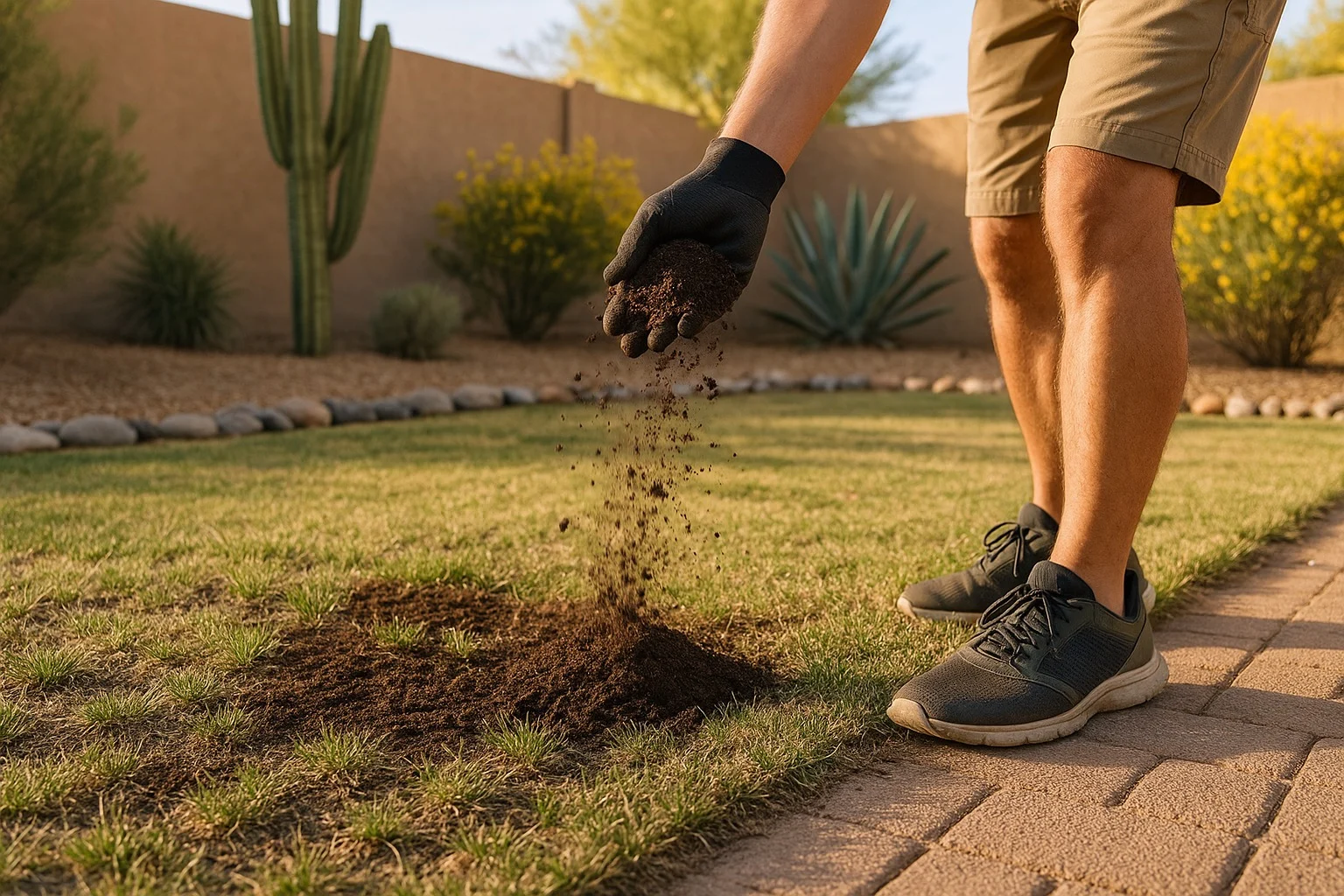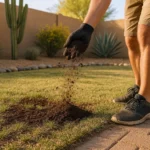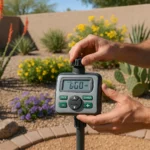As Southeast Valley temperatures begin their steady climb toward summer, it’s time for local homeowners to prepare their lawns for the seasonal transition. Using compost starters during this shift to warm-season grasses can make all the difference between a patchy, struggling lawn and a lush, vibrant one. Having worked with countless yards across Gilbert, Chandler, and Mesa, I’ve seen firsthand how proper composting techniques can transform our desert lawns during this critical transition period.
Understanding Warm-Season Grass Transitions in the Southeast Valley
Our unique desert climate in the Southeast Valley presents specific challenges for lawn maintenance. As daytime temperatures consistently reach above 65°F (typically by late March or early April), warm-season grasses like Bermuda begin to emerge from dormancy while any winter ryegrass begins to struggle. This transition period is crucial – and often frustrating for homeowners who watch their once-green lawns go through an awkward “in-between” phase.
The key to a smoother transition lies in soil health. Warm-season grasses thrive in nutrient-rich soil with good microbial activity – exactly what quality compost provides. Without proper soil preparation, your Bermuda or other warm-season grass may emerge slowly, unevenly, or with weak growth patterns that leave your lawn susceptible to weed invasion and heat stress.
In our Southeast Valley communities, where summer temperatures regularly exceed 110°F, creating resilient turf through proper transition techniques isn’t just about aesthetics – it’s about lawn survival. Properly composted soil retains moisture more effectively, reducing water requirements during our hottest months while promoting deeper root systems that can better withstand heat stress.
What Exactly Is a Compost Starter?

A compost starter (sometimes called a compost activator) is essentially a concentrated source of microorganisms and nutrients designed to accelerate the decomposition process in compost. For lawn transitions, these products introduce beneficial bacteria and fungi that break down organic matter and release nutrients in forms that grass roots can readily absorb. Think of it as a probiotic for your soil – it introduces the “good bugs” that create a healthy growing environment.
Commercial compost starters typically come in powder, liquid, or granular forms and contain a blend of microorganisms, enzymes, and sometimes nitrogen sources to kick-start microbial activity. Some popular options available at Southeast Valley garden centers include Dr. Earth Compost Starter, Espoma Organic Traditions Compost Starter, and Jobe’s Organics Compost Starter. Each has slightly different formulations, but all serve the same essential purpose.
You can also create your own compost starter using materials you likely have on hand. A simple homemade starter can be made by mixing a few cups of finished compost (which already contains active microbes) with molasses (to feed the microbes) and water. This homemade solution works particularly well in our Southeast Valley climate where the natural decomposition process is already accelerated by our heat.
Timing Your Compost Application for Optimal Results
Timing is everything when using compost starters for warm-season grass transitions in the Southeast Valley. The ideal window begins about 2-3 weeks before your warm-season grass typically breaks dormancy. For most of our area, this means early to mid-March, though this can vary slightly depending on your specific microclimate (Mesa tends to warm up slightly earlier than some parts of Gilbert, for instance).
Apply your compost starter when soil temperatures at a 2-inch depth consistently reach 55-60°F. This ensures the microorganisms in your starter will remain active rather than going dormant in cold soil. If you’re overseeding with ryegrass in winter, plan to apply your compost starter after the last mowing of your winter grass but before your Bermuda or other warm-season variety begins active growth.
Weather conditions also matter significantly. Choose a day with moderate temperatures (65-80°F) for application, and avoid periods of heavy rain or extreme heat. Early morning application gives the microbes time to begin activity before the intense afternoon sun. If you’re unsure about timing, the emergence of spring weeds in your neighborhood is often a reliable indicator that soil temperatures have reached the appropriate range for compost starter application.
Step-by-Step Application Process
Proper application of compost starter for your warm-season grass transition requires some preparation and attention to detail. Begin by mowing your lawn slightly shorter than usual – about 1.5 inches for most Southeast Valley lawns. This allows better contact between the compost materials and soil surface. Remove excess thatch if it’s thicker than 1/2 inch, as this can prevent your compost amendments from reaching the soil.
For a typical quarter-acre Southeast Valley lot with established lawn, you’ll need approximately 4-6 cubic yards of compost for a 1/4 inch application. Spread the compost evenly across your lawn using a lawn spreader for granular products or a garden sprayer for liquid formulations. For raw compost, use a shovel to create small piles throughout the yard, then rake to distribute evenly. The goal is a thin, consistent layer rather than thick patches.
After application, water the lawn thoroughly but not to the point of runoff. This initial watering activates the compost starter and helps it begin working into the soil. For the next two weeks, maintain consistent soil moisture with light, frequent watering in the early morning. This period is critical for microbial establishment and activity. Avoid heavy foot traffic on the lawn during this time to prevent compaction of your newly amended soil.
Creating Your Own Compost Tea for Enhanced Results
While commercial compost starters work well, many Southeast Valley homeowners have found success with compost tea as a supplement to their transition process. Compost tea is essentially a liquid extract of compost that concentrates beneficial microorganisms and nutrients. It can be applied as a soil drench or foliar spray to enhance the microbial activity in your lawn’s ecosystem.
To make compost tea suited for our local conditions, fill a 5-gallon bucket about one-third full with finished, high-quality compost. Add water until the bucket is about 80% full, then add 1/4 cup of unsulfured molasses (which feeds the microbes). Stir vigorously for several minutes to incorporate oxygen, then let the mixture steep for 24-48 hours in a shaded area. Stir occasionally during this period to maintain oxygen levels. The resulting tea should have an earthy smell – if it develops a foul odor, discard it and start over as anaerobic bacteria have likely taken over.
Apply your compost tea to your lawn using a garden sprayer in the early morning or evening when temperatures are moderate. This approach works particularly well for problematic areas of your lawn that struggle during transition, such as sections with poor soil or excessive shade. The liquid format allows for targeted application and quick absorption, giving these challenging areas an extra boost.
Addressing Common Southeast Valley Transition Challenges
Our unique climate creates specific challenges during grass transitions. Clay soils common in parts of Chandler and Gilbert can become compacted, limiting the effectiveness of compost applications. If you have clay soil, consider aerating your lawn before applying compost starter. This creates channels for the compost to penetrate deeper into the soil profile where it can benefit grass roots more effectively.
Another common issue in our region is salt buildup from irrigation with hard water. If white crust appears on your soil surface, your compost application should include extra organic matter to help flush salts below the root zone. Gypsum can also be added to your compost mix at a rate of about 5 pounds per 1,000 square feet to help displace sodium ions.
Uneven transitions are perhaps the most frustrating challenge – where some lawn areas green up quickly while others remain dormant. This typically indicates soil inconsistencies across your yard. Target these slower areas with additional compost tea applications every 7-10 days during the transition period. For severely struggling sections, consider applying a thin topdressing of compost (1/8 inch) specifically to these areas as a booster treatment.
Maintenance After Compost Application
Once your compost starter has been applied and your warm-season grass begins actively growing, proper maintenance ensures continued benefits throughout the growing season. Adjust your mowing height to 1.5-2 inches for Bermuda grass (the most common warm-season variety in our area) once it’s actively growing. This height promotes lateral growth and helps shade out potential weeds.
Water deeply but infrequently to encourage deep root development. For most Southeast Valley lawns in summer, this means watering to a depth of 6 inches every 3-4 days rather than daily shallow watering. The improved soil structure from your compost application should allow for better water penetration and retention, potentially reducing your overall water usage despite our intense summer heat.
Continue to support soil health throughout the growing season with monthly applications of compost tea at half strength. This maintains microbial activity without overloading the system. Avoid synthetic fertilizers for at least 30 days after your initial compost application, as these can disrupt the microbial communities you’ve worked to establish. When you do fertilize, choose organic options that complement rather than compete with your compost ecosystem.
Troubleshooting Common Issues
Despite careful planning, issues can arise during the transition process. If you notice your lawn developing yellow patches about 2-3 weeks after compost application, this could indicate nitrogen drawdown – a temporary condition where microbes consume available nitrogen during decomposition. Address this by applying a light organic nitrogen source like blood meal at a rate of 5 pounds per 1,000 square feet.
Fungal issues sometimes emerge during transition periods, particularly if we experience an unusually humid spring. The presence of small mushrooms is actually a positive sign of decomposition, but persistent brown patches with visible fungal growth may require intervention. Apply a compost tea with added garlic extract (steep 3-4 crushed garlic cloves in your tea during the last 12 hours) as a natural antifungal treatment.
If your lawn appears to be transitioning very slowly despite compost application, soil temperature may be the limiting factor. In shaded areas or during cooler springs, consider applying a thin layer of dark compost (1/8 inch) over slow areas to absorb more solar radiation and warm the soil faster. This technique is particularly effective in yards with mature shade trees that might otherwise delay warm-season grass emergence.
Long-Term Benefits of Compost-Assisted Transitions
Investing time in proper compost-assisted lawn transitions pays dividends throughout the growing season and beyond. Southeast Valley homeowners who use this approach consistently report lawns that require up to 30% less water during summer months – a significant benefit in our desert climate where water conservation is increasingly important. The improved soil structure creates better drainage during monsoon season while enhancing moisture retention during dry periods.
Disease resistance also improves markedly in lawns transitioned with compost starters. The diverse microbial ecosystem creates competition for potential pathogens, naturally suppressing many common lawn diseases. This means fewer chemical interventions are needed throughout the growing season. Many of my clients across Gilbert and Chandler have been able to eliminate fungicide applications entirely after switching to compost-based transition methods.
Perhaps most importantly for many homeowners, properly transitioned lawns simply look better throughout the challenging summer months. The deeper root systems developed during a healthy transition help grass remain green even during the hottest periods, when poorly established lawns typically develop brown patches and stress symptoms. This aesthetic benefit comes with less work and fewer inputs – truly a win-win for Southeast Valley residents looking to maintain beautiful, sustainable landscapes.






